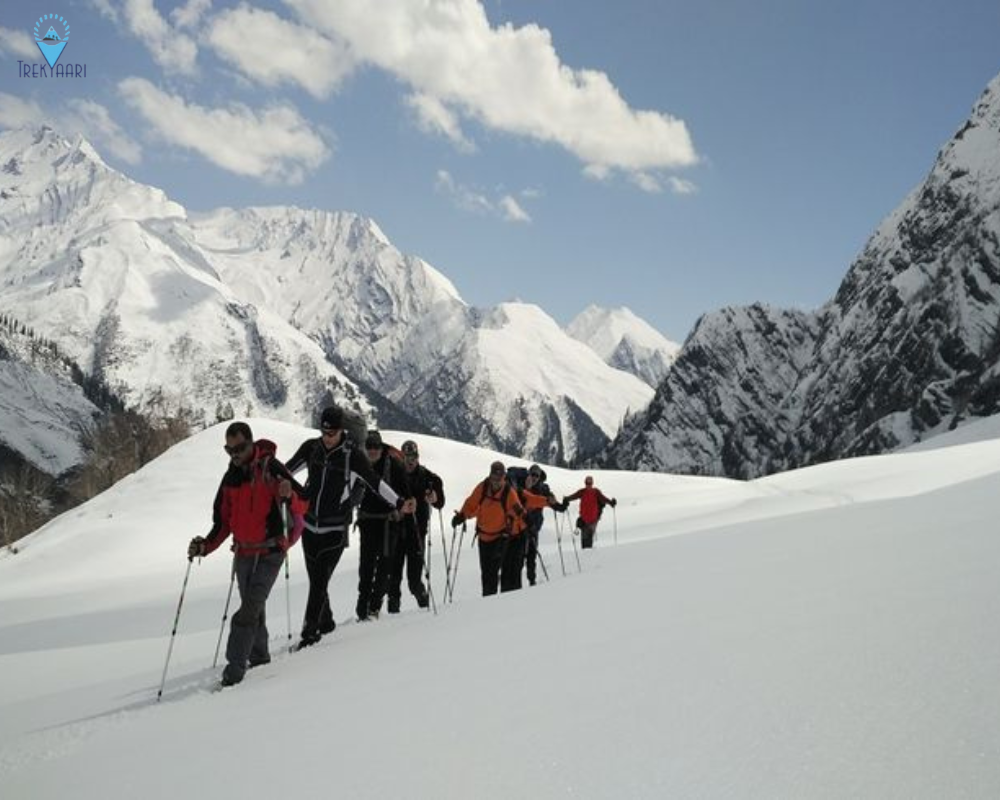Best Practices for a Memorable Friendship Peak Expedition

Embarking on an expedition to Friendship Peak in the Pir Panjal range of Himachal Pradesh, India, is an exhilarating adventure that combines the thrill of mountaineering with the beauty of the Himalayas. Standing at an elevation of 5,289 meters (17,348 feet), Friendship Peak offers a challenging yet rewarding experience for climbers. Whether you’re a seasoned mountaineer or a trekking enthusiast looking to take on a new challenge, adhering to best practices is essential for ensuring a safe, successful, and memorable expedition. Here are some key practices to keep in mind as you prepare for your journey to the summit of Friendship Peak.
Friendship Peak Expedition
Embarking on a Friendship Peak expedition is an exciting and demanding endeavor that requires careful planning and thorough preparation. From physical conditioning and gear selection to acclimatization and environmental responsibility, every aspect of the expedition plays a crucial role in the success and enjoyment of your climb. By following these best practices, you can ensure a safe and memorable experience on Friendship Peak.
Comprehensive Physical Training
Physical fitness is the cornerstone of a successful mountaineering Friendship Peak expedition. Preparing your body for the rigors of high-altitude climbing involves building strength, endurance, and cardiovascular fitness.
- Endurance Training: Engage in activities such as long-distance running, hiking, and cycling to build stamina. Aim to exercise at least 3-4 times a week, progressively increasing the duration and intensity of your workouts.
- Strength Training: Focus on exercises that strengthen your core, legs, and upper body. Squats, lunges, deadlifts, and pull-ups are excellent for building the necessary strength for mountaineering.
- Cardiovascular Fitness: Incorporate high-intensity interval training (HIIT) to improve your cardiovascular health. Activities like running, swimming, and cycling can enhance your aerobic capacity.
- Altitude Training: If possible, train at higher altitudes to help your body adapt to the reduced oxygen levels you’ll encounter on the expedition. Alternatively, use a high-altitude training mask to simulate such conditions.
- Mental Preparation: Develop mental resilience through meditation, visualization, and stress management techniques. A strong mind is just as important as a strong body in high-altitude climbing.
Proper Gear and Equipment
Having the right gear is critical for safety and comfort during your expedition. Invest in high-quality equipment and ensure everything is in good working condition before your trip.
- Clothing: Layering is key to staying warm and dry. Pack moisture-wicking base layers, insulating mid-layers, and waterproof outer layers. Don’t forget a down jacket for extreme cold.
- Footwear: Sturdy, waterproof mountaineering boots with good ankle support are essential. Break them in well before your expedition to avoid blisters.
- Mountaineering Gear: Essential items include a climbing helmet, harness, crampons, ice axe, and trekking poles. Ensure you are familiar with using all equipment.
- Other Essentials: Pack a good-quality sleeping bag rated for sub-zero temperatures, a lightweight tent, a reliable backpack, and a headlamp with extra batteries.
Acclimatization and Altitude Sickness Management
Proper acclimatization is vital to prevent altitude sickness and ensure a safe ascent.
- Acclimatization Schedule: Follow a gradual ascent, allowing your body time to adapt to the altitude. Spend a few days at intermediate altitudes and avoid rapid ascents.
- Hydration and Nutrition: Stay well-hydrated and eat high-energy foods to fuel your body. Avoid alcohol and caffeine, which can exacerbate dehydration.
- Recognizing Symptoms: Be aware of the symptoms of altitude sickness, such as headaches, nausea, dizziness, and shortness of breath. If symptoms worsen, descend immediately and seek medical attention.
Detailed Route Planning and Weather Monitoring
Understanding the route and keeping an eye on weather conditions are critical for a successful climb.
- Route Knowledge: Study the route in detail, including the terrain, key landmarks, and potential hazards. Familiarize yourself with the different sections of the climb, from base camp to the summit.
- Best Time to Climb: The ideal time for a Friendship Peak expedition is between May and September when the weather is relatively stable. However, always be prepared for sudden weather changes.
- Weather Monitoring: Keep track of weather forecasts leading up to and during the expedition. Be flexible with your schedule to accommodate weather-related delays.
Optimal Nutrition and Hydration
Proper nutrition and hydration are crucial for maintaining energy levels and overall health during the expedition.
- Meal Planning: Plan balanced meals that include carbohydrates, proteins, and fats. Freeze-dried meals are convenient and lightweight options for high-altitude expeditions.
- Hydration: Drink plenty of water throughout the day, aiming for at least 3-4 liters. Use a hydration bladder or water bottles with insulation to prevent freezing.
- Snacks and Supplements: Carry high-energy snacks like nuts, dried fruits, energy bars, and chocolate. Consider supplements such as electrolytes and vitamins to maintain your energy levels.
Safety and Risk Management
Safety should be your top priority throughout the expedition.
- Qualified Guide: Hire a certified mountain guide with experience on Friendship Peak. Their expertise in navigation, weather assessment, and emergency response is invaluable.
- Emergency Protocols: Familiarize yourself with emergency protocols and have a contingency plan in place. Carry a first-aid kit and know how to use it.
- Risk Assessment: Regularly assess risks and make conservative decisions. Avoid unnecessary risks and always prioritize safety over summit success.
Effective Team Dynamics and Communication
A cohesive team and effective communication are vital for a smooth expedition.
- Building a Team: Select team members who are physically fit, experienced, and share a positive attitude. Trust and cooperation are essential.
- Communication Strategies: Establish clear communication protocols, including hand signals and radio use. Regularly check in with team members to ensure everyone is safe and on the same page.
- Conflict Resolution: Address conflicts promptly and constructively. A harmonious team dynamic is crucial for maintaining morale and achieving success.
Mastering Technical Skills
Having the necessary technical skills is crucial for a safe ascent.
- Basic Mountaineering Skills: Ensure you are proficient in basic skills such as rope handling, belaying, and self-arrest techniques.
- Ice Climbing: Practice ice climbing techniques, including using crampons and ice axes, and climbing on different types of ice.
- Crevasse Rescue: Learn and practice crevasse rescue techniques, including rope management and pulley systems, to be prepared for emergencies.
Commitment to Environmental Responsibility
Preserving the pristine environment of the Himalayas is a shared responsibility.
- Leave No Trace: Follow Leave No Trace principles, including packing out all trash, minimizing campfire impact, and respecting wildlife.
- Environmental Impact: Use biodegradable products and avoid single-use plastics. Be mindful of your environmental footprint and strive to minimize it.
- Local Culture: Respect local customs, traditions, and regulations. Engage with the local community in a positive and respectful manner.
Mental and Emotional Preparation
Mental and emotional resilience are key components of a successful expedition.
- Managing Stress: Use relaxation techniques such as deep breathing, meditation, and visualization to manage stress and anxiety.
- Staying Motivated: Set small, achievable goals to maintain motivation. Celebrate milestones along the way to keep spirits high.
- Coping with Setbacks: Accept that setbacks are part of the journey. Stay flexible, adapt to changing conditions, and maintain a positive attitude.
Efficient Packing and Gear Maintenance
A well-organized packing list ensures you have all the essentials without overpacking.
- Comprehensive List: Include clothing, mountaineering gear, camping equipment, food, and personal items. Double-check your list to ensure nothing is forgotten.
- Efficient Packing: Pack efficiently to balance weight and accessibility. Distribute weight evenly and ensure easy access to frequently used items.
- Gear Readiness: Test all gear before the expedition to ensure it is in good working condition. Make any necessary repairs or replacements well in advance.
Thorough Pre-Expedition Logistics
Taking care of logistical details beforehand helps avoid last-minute stress.
- Permits and Permissions: Obtain all necessary permits and permissions required for the expedition. Check with local authorities for specific requirements.
- Travel Arrangements: Plan your travel to and from the starting point of the expedition. Arrange accommodation for pre- and post-expedition stays.
- Insurance: Purchase comprehensive travel and health insurance that covers high-altitude trekking and mountaineering. Ensure your policy includes emergency evacuation.
Mindful Post-Expedition Recovery
Proper recovery after the expedition is essential for physical and mental well-being.
- Physical Recovery: Allow your body time to rest and recover. Engage in light activities like walking and stretching to aid recovery.
- Reflecting on the Experience: Take time to reflect on your journey, the challenges you overcame, and the achievements you made. Document your experiences in a journal or blog.
- Sharing Your Journey: Share your experiences with friends, family, and fellow climbers. Your story can inspire others and provide valuable insights for future expeditions.
Conclusion
A successful Friendship Peak expedition requires meticulous preparation, physical and mental resilience, and a deep respect for the natural environment. By following these best practices, you can enhance your chances of a safe and memorable climb. Remember, the journey is as important as the destination, and every step taken on this incredible adventure contributes to your growth as a mountaineer and an individual.







